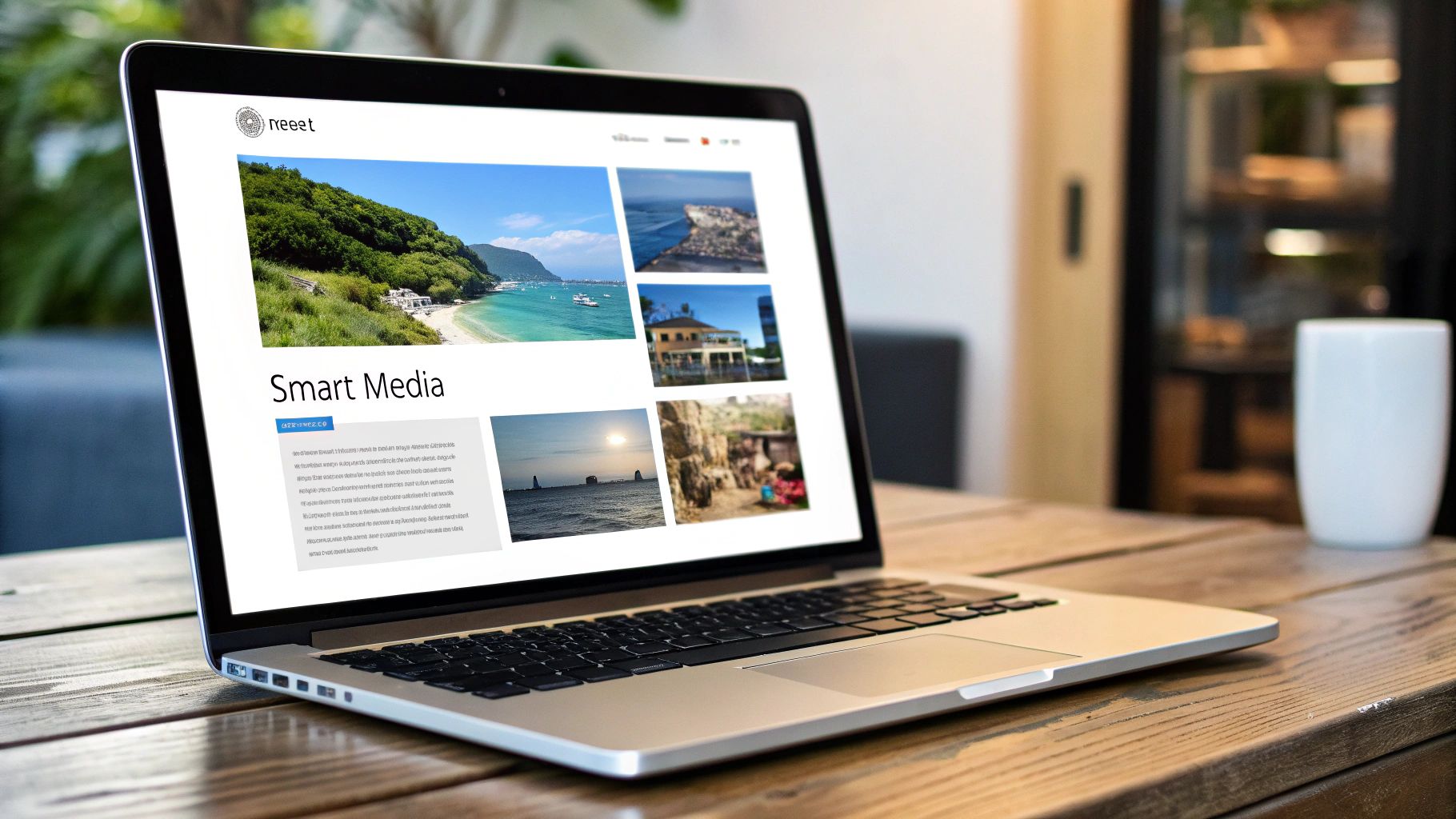9 Responsive Design Best Practices for 2025
Updated: August 12, 2025

Ever built a website that looked perfect on your laptop, only to see it turn into a jumbled mess on your phone? It happens to the best of us. In a world with countless screen sizes, a site that ‘just works’ everywhere isn’t a nice-to-have; it's essential for survival.
But what does "just working" really mean? It’s not about shrinking a desktop site. It’s about creating a smart, flexible experience that feels natural on every device. This is where responsive design best practices become your superpower.
We're not talking about abstract theory here. This guide is your playbook, filled with nine practical steps to transform how you build. We'll cover everything from thinking mobile-first to making your site lightning-fast. Let's start building digital products that don't just adapt, but truly shine on any screen.
1. Mobile-First Design Approach#
Imagine you're packing for a trip. Do you start by stuffing everything you own into a giant suitcase, then try to cram it into a tiny backpack? Of course not. You start with the backpack, packing only the essentials. That's the mobile-first approach.
You begin by designing for the smallest screen. This forces you to focus on what’s most important. Once you have a clean, simple design for mobile, you can add more features for bigger screens. It’s a strategy called "progressive enhancement." This isn’t just a trend; it's one of the smartest responsive design best practices out there.

This method naturally leads to cleaner code, faster websites, and happier users on their phones. Think about the Instagram or Airbnb apps. They show you exactly what you need on mobile and then add extra details on desktop. For developers building apps with Next.js, this mindset is priceless. You can explore how this approach aids in building cross-platform mobile apps to see how it works in practice.
How to Implement It#
Ready to try it? Start your design in a narrow window (like 320 pixels wide). Make sure buttons are easy to tap with a thumb. Most importantly, test on a real phone, not just a simulator, to see how it really feels.
2. Flexible Grid Systems#
Think of your website's layout like a bookshelf. A fixed-width layout is like having fixed, solid dividers. You can only fit certain-sized books. A flexible grid is like having adjustable dividers. You can slide them around to fit any book, big or small.
Instead of using rigid pixel measurements (pixels are fixed-size dots on a screen), flexible grids use relative units like percentages. This allows your layout to stretch and shrink smoothly, so your content looks great on any screen. Embracing these grids is a core part of responsive design best practices.

Modern tools like CSS Grid and Flexbox make this easier than ever. Look at how news sites like The Guardian rearrange their stories for different devices. They prove that a fluid foundation is key to a great user experience. If you want to dive deep into modern layouts, check out Jen Simmons' resource site.
How to Implement It#
Ready to make your layouts flow? Use CSS Grid for complex, two-dimensional layouts (think rows and columns, like a checkerboard). Use Flexbox for simpler, one-dimensional arrangements (like a single row of buttons). A good trick is to set a maximum width on your main container so text doesn't get too wide and hard to read on huge screens.
3. Responsive Images and Media#
Have you ever waited forever for a website to load, only to see a huge image slowly appear? Heavy images can kill your site's speed, especially on mobile. Responsive images are the solution. They are a vital part of responsive design best practices.
This isn’t just about making images smaller. It’s a smart system that sends the right-sized image to the right device. A 4K TV gets a big, beautiful image, while a smartphone gets a smaller, faster-loading one. It's like Netflix sending you the video quality that best fits your internet speed.

This is done with special HTML code. For developers using Next.js, the built-in image component handles a lot of this for you automatically. It resizes, optimizes, and even converts images to modern, faster formats. You can learn more by checking the official Next.js documentation on Image Optimization.
How to Implement It#
Start by using HTML5’s built-in features. The srcset attribute lets you provide a list of different-sized images, and the browser picks the best one. For even more control, like offering different image formats (like modern WebP with an older PNG as a backup), use the <picture> element. Also, remember to "lazy load" images that are further down the page so they don't slow down the initial load.
4. Strategic Breakpoint Planning#
In the old days, designers would create a "desktop version" and a "mobile version." But with so many different screen sizes today, that approach no longer works. Instead of designing for specific devices, we need a better strategy.
A breakpoint is the point at which your website's layout changes. Strategic breakpoint planning means you let your content decide where those points are. This is a key principle of modern responsive design best practices. The idea is simple: change the layout only when it starts to look bad.

This content-first method leads to a cleaner, more robust design. Look at Spotify's web player. As you resize the window, the layout doesn't just shrink; it intelligently reconfigures itself. The sidebar might disappear, or the controls might move. This is the result of smart breakpoint planning that keeps the app usable on any screen.
How to Implement It#
Start with your mobile design and slowly make your browser window wider. The moment your layout looks stretched or awkward—that's your first breakpoint. Add a new layout rule there. A pro tip is to use em units for your breakpoints, which are relative to the user's font size, making your site more accessible. Stick to just a few major breakpoints to keep things simple.
5. Touch-Friendly Interface Design#
Ever tried tapping a tiny link on your phone and accidentally hit the one next to it? It’s super frustrating. Touch-friendly design is all about preventing that. It's a critical part of responsive design best practices that focuses on making interactions easy for fingers, not just mouse pointers.
This means making buttons and links big enough to tap accurately. It also means leaving enough space between them to avoid mistakes. Think about how easy it is to use an app like Uber. The buttons are big, clear, and easy to hit, even when you're in a hurry. That's no accident.
When your site is easy to use with a thumb, people are happier and more likely to stick around. This is especially true when building mobile apps with a tool like Next.js. For a deeper look, you can explore some essential mobile app UI design best practices.
How to Implement It#
Ready to make your design more "thumb-friendly"? Follow the guidelines. Apple suggests touch targets should be at least 44x44 pixels, while Google recommends 48x48. Make sure there’s enough space between interactive elements. And always give visual feedback, like a button changing color when pressed, so users know their tap was registered.
6. Performance Optimization Strategies#
A beautiful responsive site that loads slowly is like a sports car with no engine. It looks nice, but it's useless. Performance is one of the most important responsive design best practices because speed keeps users happy. A slow site will make them leave.
This means doing everything you can to make your site fast on all devices, even on a weak mobile connection. It's about respecting the user's time and data. Innovations like Progressive Web Apps (PWAs) were born from this need. Twitter Lite, for example, is a super-fast version of Twitter that works great on slow networks, which helped them grow their user base.
How fast is your site? It's important to track your performance. You can see the impact of your work by tracking the 10 key website metrics for growth.
How to Implement It#
Start by using a tool like Google's PageSpeed Insights to find what's slowing your site down. Make sure the content at the top of the page loads first so users see something right away. Use "lazy loading" for images and compress all your files (CSS, JavaScript, and images) to make them smaller. For developers, this is key to building a snappy app. You can learn more about improving mobile app performance.
7. Content Strategy and Hierarchy#
Great responsive design isn't just about moving boxes around. It's about showing the right information at the right time. A smart content strategy is one of the most overlooked responsive design best practices.
This means organizing your information so it's easy to understand on any device. You don't hide content on mobile; you prioritize it. You show the most important things first and let users dig for more if they want to. This is called "progressive disclosure."
Think about how Amazon shows products. On mobile, you see the key details first: the picture, the price, and the "Add to Cart" button. More information, like reviews and specifications, is available further down. This layered approach feels clean and efficient.
How to Implement It#
Start by figuring out what content is absolutely essential for your mobile users. Use progressive disclosure to reveal more complex information in stages. This helps prevent users from feeling overwhelmed on small screens. This method is a core part of planning an app's journey, and you can explore how to build a comprehensive mobile app development roadmap to learn more.
8. Cross-Browser and Device Testing#
A design that looks perfect on your computer can fall apart on someone else's. That’s why testing your work on different browsers and devices is one of the most essential responsive design best practices.
What works in Chrome on a Mac might look broken in Safari on an iPhone. Skipping this step is like building a car and only testing it on one road. You'd never do that. Rigorous testing ensures everyone gets a consistent, reliable experience. It catches those annoying bugs that drive users away.
Services like BrowserStack exist for this very reason. Even small differences between browsers can cause big problems. For developers building an app with Next.js, this step is vital to make sure your app works perfectly on both iOS and Android. Our comprehensive mobile app testing checklist can help you build a solid testing plan.
How to Implement It#
First, use your website analytics to see which browsers and devices your audience uses most. Create a checklist to test on those top combinations. Use a mix of automated tools for quick checks and manual testing on real phones and tablets for a true feel of the user experience. Don't forget to test on slow network connections to see how your site performs in the real world.
9. Accessibility-First Responsive Design#
A truly responsive website adapts to more than just screen sizes; it adapts to people. An accessibility-first approach ensures your site is usable by everyone, including people with disabilities. This is one of the most humane and crucial responsive design best practices.
This means thinking about accessibility from the very start, not as a final step. For example, how will someone using a screen reader navigate your mobile menu? Will a person with low vision be able to read your text on a tablet? A site might look great but be impossible for some people to use.
Great examples include GOV.UK, which prioritizes clarity for all users, and Microsoft’s Inclusive Design toolkit. By building with accessibility in mind, you create a better experience for everyone and save yourself a lot of work later on.
How to Implement It#
Start by making sure your headings (H1, H2, H3) are in a logical order on every screen size. Use online tools to check that your text has enough color contrast to be easily readable. Most importantly, try using a screen reader on your phone and desktop to understand what the experience is like. Adding a "skip to content" link is a simple but powerful feature for users who navigate with a keyboard.
Responsive Design Best Practices Comparison#
| Approach/Strategy | Implementation Complexity 🔄 | Resource Requirements ⚡ | Expected Outcomes 📊 | Ideal Use Cases 💡 | Key Advantages ⭐ |
|---|---|---|---|---|---|
| Mobile-First Design Approach | Medium (requires upfront planning) | Moderate (design & testing) | Better mobile performance, simplified core content | Mobile-focused apps/sites, growing mobile usage | Improved UX on small screens, future-proofing |
| Flexible Grid Systems | Medium to High (CSS expertise) | Moderate (design & code) | Fluid layouts, consistent design across devices | Responsive multi-column layouts, dynamic content | Seamless adaptation, scalable units |
| Responsive Images and Media | Medium (image management) | Higher (multiple image versions) | Faster loading, optimized visuals | Media-rich sites, varying device capabilities | Bandwidth saving, quality across devices |
| Strategic Breakpoint Planning | Medium (detailed planning) | Low to Moderate | Content-driven responsiveness, maintainability | Complex layouts needing flexible breakpoints | Device-agnostic design, reduced CSS complexity |
| Touch-Friendly Interface Design | Low to Medium (UI adjustments) | Low to Moderate | Improved mobile usability, reduced input errors | Touchscreen devices, mobile-first interfaces | Accessibility, user engagement |
| Performance Optimization Strategies | High (multiple optimizations) | High (monitoring & tools) | Faster load times, better SEO, lower bounce rates | All responsive sites, slower networks | Enhanced performance, optimized resource use |
| Content Strategy and Hierarchy | High (content audit & planning) | Moderate to High | Clearer hierarchy, better user task completion | Content-heavy responsive sites | Reduced cognitive load, improved discoverability |
| Cross-Browser and Device Testing | High (extensive testing processes) | High (devices & tools) | Consistent experience, fewer bugs | Multi-platform, multi-device environments | Early issue detection, higher user satisfaction |
| Accessibility-First Responsive Design | Medium to High (accessibility expertise) | Moderate (testing & design) | Inclusive access, legal compliance | Public websites, services for diverse users | Broader reach, improved SEO, better usability |
Putting It All Together: Your Blueprint for Responsive Excellence#
We've covered a lot, from thinking mobile-first to ensuring your site is fast and accessible. But these nine practices aren't just a checklist. They are ingredients in a recipe for building experiences that people love.
The one thing that connects all these ideas is empathy. It’s about putting yourself in your user's shoes. Think of the person trying to use your site on a shaky train, the student on a tablet in a coffee shop, or the professional on a huge monitor. True responsive design isn’t just about making things fit; it's about making them work for every single person.
From Principles to Practice#
So, what are the biggest takeaways? Let’s break it down to three key ideas:
Think Small to Go Big: The mobile-first approach forces you to focus on what truly matters. By perfecting the core experience on a small screen, your final product becomes stronger and clearer on all devices.
Flexibility is Your Superpower: Rigid layouts are a thing of the past. Embrace fluid grids and responsive images. This allows your design to adapt gracefully to any screen, now and in the future.
People First, Always: A fast, accessible, and easy-to-use site will always win. Performance and accessibility aren't optional extras; they are fundamental to a great user experience. Mastering these responsive design best practices isn't just a technical skill; it's a commitment to your users.
By taking these ideas to heart, you'll build more than just web pages. You'll create resilient, future-proof digital products that feel helpful and reliable. This is how you build trust, drive engagement, and create something truly great.
Ready to put these responsive design best practices into action without the headache? NextNative empowers you to build truly native mobile apps for iOS and Android using the Next.js skills you already have. Stop wrestling with breakpoints and start shipping beautiful, performant cross-platform apps faster than ever before.